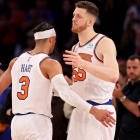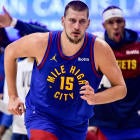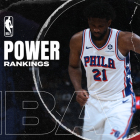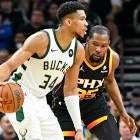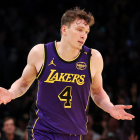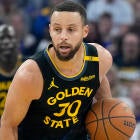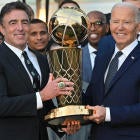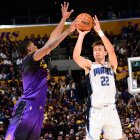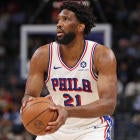
Historically speaking, the peak of trade season comes at the NBA Draft. There's a common sense to that. Win-now teams frequently want to turn their picks into immediate players, and that becomes harder once the pick becomes an actual player who other teams may not be interested in. Free agency offers the chance to replace players who were dealt. Teams are at their most flexible on draft night. They have the whole offseason in front of them to figure out any roster problems that arise that night.
But, at least from a veteran standpoint, the 2024 NBA Draft was relatively light on the trade front. No active players were traded during the first round. The Mikal Bridges blockbuster came before, as did the Deni Avdija trade, but once the picks started coming, the player-based trades largely stopped. Thursday's second round saw no-names like Wendell Moore and Lindy Waters move, but nobody of real substance.
And so, trade season has yet to peak in the NBA. All 30 teams could probably afford a tune up or two, but five teams stand out at the moment for specific reasons. These aren't the five teams that need trades most in the entire NBA. They are the five teams that, as a direct result of their choices before and during the draft, have a specific sort of trade they need to make sooner rather than later. Ideally, these moves will come either before the free agency frenzy begins or soon afterward, because the longer these teams wait, the harder things are going to become.
New York Knicks
The Knicks made their splash already when they landed Bridges. Now comes the more tedious part: filling out the roster around him. In theory, the Knicks could stick with what they have. They are currently below the first-apron hard cap that the Bridges trade, in its current incarnation, set for them. The only rotation piece from last season missing would be free agent Isaiah Hartenstein, who they were going to struggle to re-sign anyway because of Early Bird Rights restrictions. As it stands right now, the Knicks have a path to a starting lineup of Bridges, Jalen Brunson, OG Anunoby, Julius Randle and Mitchell Robinson with Donte DiVincenzo, Josh Hart and Deuce McBride off of the bench. That's a contender.
It's just a risky one. Hartenstein was essential last year partially because of how good he was, but also because of how injury-prone Robinson is. He has averaged around 48 games played per year over the past four seasons. The Knicks could live with this when they had a second starting-caliber center in Hartenstein, but New York cannot reasonably expect to go into next season with Robinson as the only viable center. They need an insurance policy of some sort, and retaining Precious Achiuwa isn't going to cut it.
That leaves them with two viable options, all of which are going to require a trade of some sort:
- In a perfect world, the Knicks would re-sign Hartenstein. He would have to take a slight discount by accepting a four-year, $72.5 million deal, but if he's willing to do it, the Knicks are going to have to expand the Bridges trade so that they send out more money than they take in. This would allow them to use the second apron (roughly $189.5 million) as a hard cap instead of the first (roughly $178.7 million). Bridges makes roughly $4.3 million more than Bojan Bogdanovic, so the Knicks would have to make up the difference in some other way. They could potentially trade Deuce McBride and his $4.7 million salary to do so, but McBride's three-year extension is so cheap that the Knicks are going to want to keep him for when everyone else gets expensive. More likely, the Knicks are trading either Robinson ($14.3 million) or Randle ($30.3 million) to facilitate Hartenstein. These deals could potentially bring back other players. The Knicks would just have to send out less cumulative money in the expanded trade than they take in.
- Let's say the Knicks lose Hartenstein. Do they want to go into next season with a health risk in Robinson as their only center? They could potentially get out ahead of this now by trading Robinson or Randle preemptively for a center. Let's say, for instance, the Knicks traded Randle, a $30 million player, for someone's $20 million center. That would restore their two-headed center rotation with a proper Hartenstein rotation, unlock the second apron hard cap and wipe $10 million off the books that could be reallocated to other players. You'd likely be taking a talent downgrade by giving Randle away, but considering how far the Knicks made it without him, their preference may be to stick with the "four perimeter players and one big man" approach moving forward. The alternative here would to try to trade Robinson for a cheaper center in the $9-10 million range. There are fewer options at this price point, but doing so would at least give the Knicks potential access to the tax-payer mid-level exception. Would you rather have Robinson alone, or two decent but inferior centers? That is a question New York is asking itself right now. At the most extreme end of this spectrum, the Knicks could try to dump Randle outright into someone's cap space to unlock the full non-taxpayer mid-level exception at around $13 million. This could be used to pursue a starting-caliber big man like Jonas Valanciunas on the open market.
There are dozens of possible moves that could spring out of these scenarios, and for now, it all hinges on what sort of offers Hartenstein gets. If he decides he wants to be in New York, the Knicks surely have a plan to make that financially feasible. If he doesn't? They have to find a way to set up a more reliable center rotation, because Robinson's health is too much of a risk to accept pairing him with a significantly downgraded backup.
Brooklyn Nets
The Knicks are in a desperate position to build a winner. The Nets are in a desperate position to build a loser. By reacquiring their 2025 and 2026 first-round picks from the Houston Rockets, Brooklyn signaled to the entire world that it plans to aggressively tank for the next two years. That is going to mean offloading every meaningful veteran possible in order to lose as many games as possible.
Two veterans in particular stand out here as possible targets of contenders: Cam Johnson and Dorian Finney-Smith. They are both high-end 3-and-D players on reasonable contracts, with Johnson veering closer to the "3" end of that spectrum and Finney-Smith emphasizing the "D" end of that role. There will be offers for both in the coming days, and there are reasons the Nets need to act quickly beyond losing games next season.
Finney-Smith is 31 years old. He's due for a decline in the somewhat near future. If the Nets bring him back next year and force him to play on a roster with little playmaking or shooting, he is going to look worse and get less back in a trade. Johnson is young and may actually benefit from more creation opportunities, but he has an extensive injury history, and the Nets need to move him before he risks a health issue that scares suitors off.
When the Nets traded Kevin Durant and Kyrie Irving, they held onto the role players they got back and pretended they had a real shot of building a winner with him. Those illusions are now gone. The Nets need to tear this roster down to the studs as quickly as possible.
Detroit Pistons
The Pistons currently have four lottery picks from the 2021, 2022 and 2023 drafts on their roster. Those four players combined to shoot 274-of-821 (33.3%) on 3-pointers last season. They just used the No. 5 overall pick on Ron Holland, who shot 24% on 3-pointers. Holland, Ausar Thompson and Jalen Duren are, at this point, total non-shooters. Jaden Ivey qualifies as eager but mostly ineffective. Cade Cunningham would be fine as the third- or fourth-best shooter in a starting lineup but is woefully out of place as a team's primary core marksman, especially since the fact that he is also Detroit's primary ball-handler means that he is the Piston all of the help-defenders ignoring those non-shooters will turn their attention to.
Forget about building a viable team for the 2024-25 season. Being this invested in this many bad shooters is developmentally irresponsible. How on Earth are the Pistons supposed to evaluate Ivey as a point guard in the last season before he becomes eligible for a rookie extension if he has no space with which to operate? How are they supposed to teach Thompson to function as an off-ball player under these circumstances? The Pistons aren't really in a position to be handing out long-term contracts to worthwhile veterans just to help them develop the young guys right now. They need core pieces who actually can actually augment the players they already have.
Someone has to go here. You're doing all of these players a disservice by keeping them together next season. Ivey, as a point guard on a team with a better point guard in Cunnigham, is the obvious candidate. Thompson makes some sense as well simply because the earlier he is moved, the more trade value he will have to teams that think they can teach him to shoot. But someone out of this non-shooting core needs to be moved for a player who can hit the occasional 3-pointer just so the Pistons can figure out what they have here.
Portland Trail Blazers
Portland made the right decision to draft Donovan Clingan No. 7 overall on Wednesday. He was the best player on the board by far, with the CBS Sports big board ranking him as the fourth-best prospect overall. The only problem is that the pick created a bit of a logjam for Portland. Deandre Ayton is on a max contract and shares a position with Clingan. Robert Williams III missed most of last season due to injury, but he will be back and is a proven veteran that needs minutes as well.
Ayton and Williams alone already had enough stature to struggle to fit within 48 minutes. Portland even tinkered a bit with lineups featuring both before Williams went down. If all three are going to play the minutes they deserve next season, Portland almost has to play two of them at a time for parts of the game. This would be developmentally irresponsible for the same reasons Detroit's no-shooting lineups are. The Blazers are trying to develop two young guards in Scoot Henderson and Shaedon Sharpe. Neither of them are reliable shooters yet. Deni Avdija is coming off the best shooting season of his career, but before last year, he was at roughly 31% for his career. Putting those players with two big men just isn't optimal for their growth.
Portland might argue that Ayton's mid-range shooting makes him a viable offensive power forward. In fairness, he made 51% of his shots in mid-range last year on high volume. But that figure was an anomaly. He was at 42% in his last year in Phoenix, and even if he wasn't, mid-range shooting isn't much of a spacing tool. Ayton still doesn't shoot 3's. He's made just 22 of them in his career.
Williams is the obvious player to move here, and as the Knicks proved, a strong center duo has a lot of benefits. Clingan could adjust to the NBA without playing starter minutes and Ayton could play with more energy on the defensive end if his overall workload is trimmed. Williams remains an injury risk, but he's cheap enough for someone to take a flier on a player that nearly won Defensive Player of the Year a few seasons ago. It just doesn't make sense for Portland to keep all three, but Ayton, with that max contract, is probably too expensive to trade for value.
Denver Nuggets
The Nuggets have had the best starting lineup in the NBA over the past two seasons, but the worst bench. The Nuggets have a number of young players in the pipeline that could be ready for bigger roles, but the playoffs showed just how far away most of them are. Denver can't afford to lose any of its starters, but Kentavious Caldwell-Pope just opted out of his contract. The Nuggets have full Bird Rights and can therefore pay him anything up to his max, but are presumably attempting to keep him without going over the dreaded second apron.
Given the market he is expected to receive, that could prove difficult. After trading Reggie Jackson on Thursday, the Nuggets have around $18 million in room below the second apron, but only 11 players on the roster. When you factor in filling out the roster with minimum-salary players, there is just no way Denver is going to have the money to make a competitive offer when teams like the 76ers and Magic have the cap space to to cross $20 million per year if they want to. The Nuggets have to clear more money.
The obvious way to do this would be trading Zeke Nnaji. He makes roughly $9 million next season, but he never emerged as a viable backup center and will be replaced by first-round pick DaRon Holmes. There are three intriguing paths available through a Nnaji trade on the table for Denver:
- In a perfect world, the Nuggets would simply dump him into someone's space, get to around $27 million in second apron space with 10 rostered players, and then use all of that room to both re-sign Caldwell-Pope and filled out the rest of the team from there. If this move is on the table, Denver will make it.
- Let's say Caldwell-Pope walks. If Denver can still dump Nnaji, it could get to around $16 million in room beneath the first apron. This is relevant because staying below the first apron unlocks the non-taxpayer mid-level exception (which can go up to around $13 million in the first season). Denver wouldn't be able to use all of it because it still needs to fill out the roster, but the Nuggets could at least unlock a portion of it higher than the taxpayer mid-level exception so they could outbid the other expensive teams for a free agent. Denver wouldn't find a Caldwell-Pope level 3-and-D player at that price point, but it could possibly go in another direction and add a ball-handler or defender instead and try to shift their playing style slightly to accommodate the change.
- Let's say the Nuggets are prepared to put their unprotected 2031 first-round pick on the table. As we saw with Minnesota on Wednesday night, picks that far out suddenly have more value than ever in this new, second-apron world that ensures most teams will struggle to keep contenders together for sustained periods. The Nuggets could attach that pick to Nnaji and seek out a starting-level player on a rookie deal to replace Caldwell-Pope. If Caldwell-Pope does leave, Denver would probably still have enough room in this scenario to use the taxpayer mid-level exception. That's nothing to scoff at from a depth perspective. It got the Nuggets Bruce Brown two summers ago. Effectively, the goal in this scenario would be swap out Caldwell-Pope and that 2031 first-rounder for two cheaper depth pieces.
What the Nuggets absolutely cannot do is simply let Caldwell-Pope and make no meaningful addition to replace him. Nuggets GM Calvin Booth hinted that he expects Caldwell-Pope to leave and that Christian Braun would be in line to replace him, but doing this would weaken both the starting lineup, as Braun is worse than Caldwell-Pope especially as a shooter, and the bench, as Braun would no longer be a part of it. They have to do something to either retain Caldwell-Pope or add talent in his place. Every version of that plan relies on dumping Nnaji.








